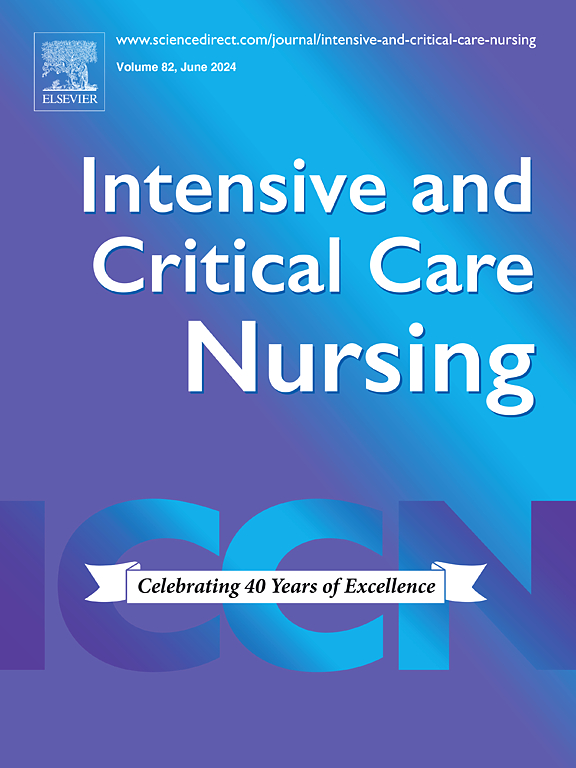报告了导致重症监护成人患者沟通脆弱性的因素
IF 4.7
2区 医学
Q1 NURSING
引用次数: 0
摘要
背景:由于患者因素,包括使用先进的气道来促进机械通气,入住重症监护病房的患者会经历沟通的脆弱性。沟通脆弱性使患者面临不良安全事件和护理中断的风险。更全面地了解包括社会关系和环境因素在内的沟通脆弱性,可以为改善重症监护病房的患者沟通和安全提供机会。目的运用残疾人权利方法,扩大我们对成人重症监护病房患者沟通脆弱性的理解。方法采用定性描述方法,包括半结构化访谈和配对内容分析。在2024年1月至4月期间,对22名参与者进行了访谈,包括11名专业不同的医疗保健提供者,7名家庭成员和4名来自加拿大多伦多一家社区学术医院的患者幸存者。采访录音和文字记录。研究结果:患者、家属和医疗保健提供者参与者经常描述了导致成人重症监护病房患者沟通脆弱性的患者、社会关系、环境和结构因素。除了患者因素外,报告的社会关系因素包括临床医生沟通培训不足。报告的环境因素包括通信工具不足,缺乏患者隐私,照明和噪音水平。报告的通信脆弱性结构性因素包括家庭包容和感染控制政策。结论:本研究报告了患者、家属和医疗保健提供者在重症监护病房中造成患者沟通脆弱性的因素。识别导致沟通脆弱性的社会关系、环境和结构相关因素为改善重症监护病房成人患者的沟通实践和安全提供了多种机会。对临床实践的启示使用残疾人权利方法来了解成人重症监护病房患者沟通的脆弱性,为基于系统的实践变革提供了社会关系和环境机会。这些措施包括系统地提供通信工具,并对照明和噪音水平进行环境扫描。本文章由计算机程序翻译,如有差异,请以英文原文为准。
Reported contributors to communication vulnerability for adult patients in critical care
Background
Patients admitted to the intensive care unit experience communication vulnerability due to patient-factors including the use of an advanced airway to facilitate mechanical ventilation. Communication vulnerability puts patients at risk for adverse safety events and breakdowns in care. A more complete understanding of communication vulnerability that includes socio-relational and contextual factors can expose opportunities to improve patient communication and safety in the intensive care unit.
Aim
To expand our understanding of patient communication vulnerability in the adult intensive care unit using a disability rights approach.
Methods
We used a qualitative descriptive methodology including semi-structured interviews and paired content analysis. Between January – April 2024, 22 participants were interviewed including 11 professionally diverse healthcare providers, 7 family members, and 4 patient survivors from a community academic hospital in Toronto, Canada. Interviews were audio recorded and transcribed.
Findings
Patient, family, and healthcare provider participants described often converging patient-, socio-relational-, environmental-, and structural- factors that contribute to patient communication vulnerability in the adult intensive care unit. In addition to patient factors, reported socio-relational factors included insufficient clinician communication training. Reported environmental factors included insufficent communication tool accessibility, lack of patient privacy, lighting and noise levels. Reported structural factors of communication vulnerability included family inclusion and infection control policies.
Conclusions
This study presents patient, family, and healthcare provider reported contributors to patient communication vulnerability in the intensive care unit beyond patient-factors. Identifying socio-relational, environmental and structural related factors contributing to communication vulnerability provides multiple opportunities to improve patient communication practices and safety for adults in the intensive care unit.
Implications for Clinical Practice
Using a disability rights approach to understanding patient communication vulnerability in the adult intensive care unit exposed socio-relational and contextual opportunities for system-based practice change. These include systemic availabilty of communication tools and conducting environmental scans of lighting and noise-levels.
求助全文
通过发布文献求助,成功后即可免费获取论文全文。
去求助
来源期刊

Intensive and Critical Care Nursing
NURSING-
CiteScore
6.30
自引率
15.10%
发文量
144
审稿时长
57 days
期刊介绍:
The aims of Intensive and Critical Care Nursing are to promote excellence of care of critically ill patients by specialist nurses and their professional colleagues; to provide an international and interdisciplinary forum for the publication, dissemination and exchange of research findings, experience and ideas; to develop and enhance the knowledge, skills, attitudes and creative thinking essential to good critical care nursing practice. The journal publishes reviews, updates and feature articles in addition to original papers and significant preliminary communications. Articles may deal with any part of practice including relevant clinical, research, educational, psychological and technological aspects.
 求助内容:
求助内容: 应助结果提醒方式:
应助结果提醒方式:


